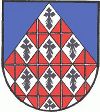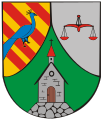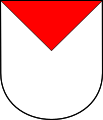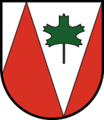Lace (heraldry)

The tip is a herald image in heraldry, heraldry .
Many names are used in the description ( blazon ) for this shield division. Wedge or spur , or pyramid or corner, denotes the point, also coat pull ( coat cut ). It is a popular and common type of division.
The tip must not be confused with the tip division . This is a form of the coat of arms cut with several small points, which is also known as the tip cut .
Training and variants
The tip is used to divide the escutcheon into three fields . This is achieved by drawing a straight line to the right and left from the middle of the upper edge of the shield to the area of the lower edge of the coat of arms (approximately in the area of the upper edge of the shield base ). This creates an area below the two dividing lines and one each on the right and left side of the coat of arms. The tip can be the first to be emblazoned , although it is "below" , so it has a dominant position.
Variants:
- The tip may increased , decreased , or only as a flat appear: at decreased or reduced the tip of the tip does not reach the upper shield edge, at increasing the base points are higher than in the normal form, flat is specifically both. When depressed, one also speaks of angled cut , otherwise it takes on the character of a heraldic figure that does not divide the shield, but rests on it (a typical use would be to depict a mountain as a green, lowered peak on blue ).
- Pyramid or corner is preferably blunt
- That project pointed only to the plate center is called half tips or also wedges , precise semi-wedges - so some authors also call the longitudinally split half a point, more specific about halved peak named.
- The angle foot is called the shield foot in the form of a very low point
- The tip , which is often curved (curled) in the middle, is called grafting when it pushes the rest of the normal crest content to one side in order to free up another space.
- A turned point is named after the location of the acute angle. It is then a right (pointing to the heraldic right, but starting from the left edge of the shield) or left tip with a 90-degree turn. At a rotation of 45 degrees to the right as it is obliquely right (in the right has Obereck) or to the left as obliquely left tip described.
- The overturned form, ie the shield division "upside down", is also a variant and, in the curved-overturned form, was previously referred to as a pocket train or a bag train .
- if one wants to explicitly name the normal position of the point, especially as a figure, one speaks of a rising point , a growing point above other figures or the shield base is also possible.
- Angular toppled and left diagonal overthrown they come from the front respectively rear upper corner.
-
Wedge is preferably a longer, slimmer shape, and in the normal shape it points downwards, but it corresponds to the normal tip, it is called rising . Ascending can also tip themselves call if likelihood of confusion (one would three peaks ascending designate, as occurred in the impression also fallen peaks, and then it is not clear what the label color and what the herald image is).
- Spur is even narrower
- If slender points, i.e. wedges, come from the upper corners so that their upper edge runs into the corner, they are called the right or left lower lap . The same overturned (in the usual coat of arms there is no corner below) they are called the right and left upper lap
- The opposite point is a point standing in front and a fallen point at the back, so that a lot of space is created. She may also have fallen, then the standing point is on the left (back). If there is half a point in front (point in the upper right corner of the shield) with a counter point (center edge of the shield base) and another half point with a counter point, this is called a split with two halved points . Placing several tips against one another is already seen as a tip cut .
- The two dividing lines can be curved. Then it is a curved (inside) or curved (outside) point. The direction of curvature determines the designation.
- a curved double arch results in the keel arch
- Cloak train is a name that emphasizes the heraldic division in the character of a heraldic image and is to be taken literally, for example in the coat of arms of the Dominicans
variants
Examples
In blue a [growing] point (of diamonds made of ermine and red, silver faceted diamonds; Hofkirchen , AT)
above a three-arched , overturned point, below a [rising] point
(speaking; Tiefgraben , AT )curved tip cut or jacket cut
( Sykkylven NO)split shield, curled or curved tip
( Steimel DE)curled, half point
( Rechtmehring DE)half turned point (wedge,
Klin PL)right tip
( Suomenniemi FI)With an opposing tip split by silver and red
( Ausservillgraten AT)
Special forms
- Corner point
- Change of position
- Breast bib (cone)
- Angular flank
- Angle head and angle shield base
- Gusset (small tips / stand, slightly larger than serrated)
Retracted tip
The space in the tip is also inserted tip or be sharpened , referred the case to a subsequent insertion: function of this peak is generally in a divided shield indemnify another place undue without reducing one of the top two spots, or In all shields, to create a distinctive place, for example for secondary lines of a gender. In the Spanish shield (old form) and other shield forms that are pointed at the foot, there is an almost diamond-shaped, thoroughly honorable place in the lowered point. The tip can also be inserted elsewhere, also on the right or left
- on the left a heraldic pattern of an inserted point in a complex coat of arms
- then Charles V : Granada inserted between places I (Castile and Aragon) and II (Kgr. both Sicilies)
- on the right an example for the occasion of a pointed point: Holy Royal Hungarian Shield, Old Hungary in front, New Hungary in the back . In 1915, for political reasons, Croatia was sharpened (with red and white shafts) (here in the common Austro-Hungarian coat of arms, the banner emphasizes the intention, which failed shortly afterwards).
Like any other space, the point can be further divided by shield divisions.
- Example: The middle Hungarian shield ( countries of the Hungarian crown ) of the same time. In the top Fiume , 1915, Bosnia is given a place of honor for war merit:
- on the right the correct order (counting) of the places of the actually quartered shield, V or V / VI pointed, VI or VII the heart shield (above shield, Croatia on 2nd place)
literature
- Gert Oswald : Lexicon of Heraldry. From apple cross to twin bars. 2nd, unchanged edition. Battenberg, Regenstauf 2006, ISBN 3-86646-010-4 , o. P.
















